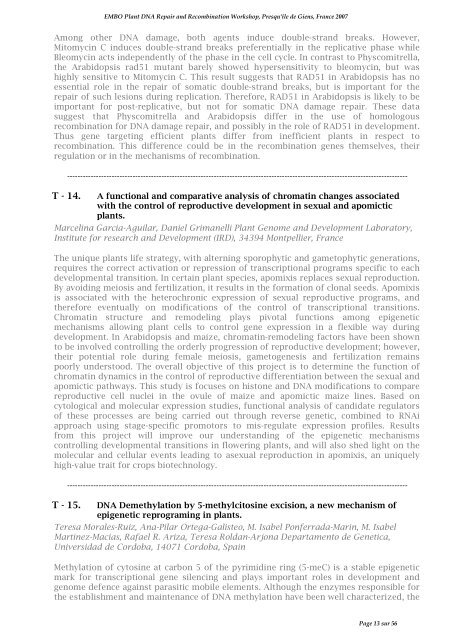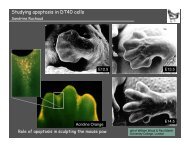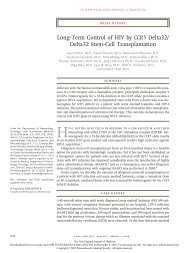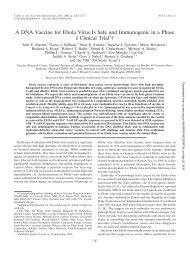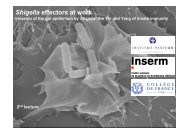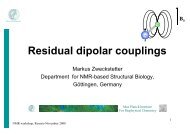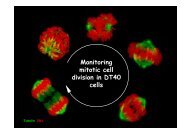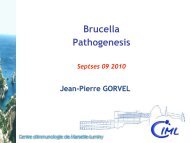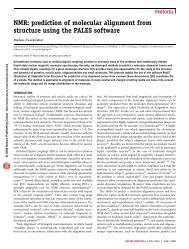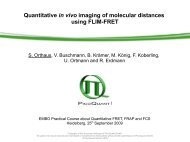pdf file - Events - EMBO
pdf file - Events - EMBO
pdf file - Events - EMBO
Create successful ePaper yourself
Turn your PDF publications into a flip-book with our unique Google optimized e-Paper software.
<strong>EMBO</strong> Plant DNA Repair and Recombination Workshop, Presqu'île de Giens, France 2007<br />
Among other DNA damage, both agents induce double-strand breaks. However,<br />
Mitomycin C induces double-strand breaks preferentially in the replicative phase while<br />
Bleomycin acts independently of the phase in the cell cycle. In contrast to Physcomitrella,<br />
the Arabidopsis rad51 mutant barely showed hypersensitivity to bleomycin, but was<br />
highly sensitive to Mitomycin C. This result suggests that RAD51 in Arabidopsis has no<br />
essential role in the repair of somatic double-strand breaks, but is important for the<br />
repair of such lesions during replication. Therefore, RAD51 in Arabidopsis is likely to be<br />
important for post-replicative, but not for somatic DNA damage repair. These data<br />
suggest that Physcomitrella and Arabidopsis differ in the use of homologous<br />
recombination for DNA damage repair, and possibly in the role of RAD51 in development.<br />
Thus gene targeting efficient plants differ from inefficient plants in respect to<br />
recombination. This difference could be in the recombination genes themselves, their<br />
regulation or in the mechanisms of recombination.<br />
----------------------------------------------------------------------------------------------------------------------------------<br />
T - 14. A functional and comparative analysis of chromatin changes associated<br />
with the control of reproductive development in sexual and apomictic<br />
plants.<br />
Marcelina Garcia-Aguilar, Daniel Grimanelli Plant Genome and Development Laboratory,<br />
Institute for research and Development (IRD), 34394 Montpellier, France<br />
The unique plants life strategy, with alterning sporophytic and gametophytic generations,<br />
requires the correct activation or repression of transcriptional programs specific to each<br />
developmental transition. In certain plant species, apomixis replaces sexual reproduction.<br />
By avoiding meiosis and fertilization, it results in the formation of clonal seeds. Apomixis<br />
is associated with the heterochronic expression of sexual reproductive programs, and<br />
therefore eventually on modifications of the control of transcriptional transitions.<br />
Chromatin structure and remodeling plays pivotal functions among epigenetic<br />
mechanisms allowing plant cells to control gene expression in a flexible way during<br />
development. In Arabidopsis and maize, chromatin-remodeling factors have been shown<br />
to be involved controlling the orderly progression of reproductive development; however,<br />
their potential role during female meiosis, gametogenesis and fertilization remains<br />
poorly understood. The overall objective of this project is to determine the function of<br />
chromatin dynamics in the control of reproductive differentiation between the sexual and<br />
apomictic pathways. This study is focuses on histone and DNA modifications to compare<br />
reproductive cell nuclei in the ovule of maize and apomictic maize lines. Based on<br />
cytological and molecular expression studies, functional analysis of candidate regulators<br />
of these processes are being carried out through reverse genetic, combined to RNAi<br />
approach using stage-specific promotors to mis-regulate expression pro<strong>file</strong>s. Results<br />
from this project will improve our understanding of the epigenetic mechanisms<br />
controlling developmental transitions in flowering plants, and will also shed light on the<br />
molecular and cellular events leading to asexual reproduction in apomixis, an uniquely<br />
high-value trait for crops biotechnology.<br />
----------------------------------------------------------------------------------------------------------------------------------<br />
T - 15. DNA Demethylation by 5-methylcitosine excision, a new mechanism of<br />
epigenetic reprograming in plants.<br />
Teresa Morales-Ruiz, Ana-Pilar Ortega-Galisteo, M. Isabel Ponferrada-Marin, M. Isabel<br />
Martinez-Macias, Rafael R. Ariza, Teresa Roldan-Arjona Departamento de Genetica,<br />
Universidad de Cordoba, 14071 Cordoba, Spain<br />
Methylation of cytosine at carbon 5 of the pyrimidine ring (5-meC) is a stable epigenetic<br />
mark for transcriptional gene silencing and plays important roles in development and<br />
genome defence against parasitic mobile elements. Although the enzymes responsible for<br />
the establishment and maintenance of DNA methylation have been well characterized, the<br />
Page 13 sur 56


